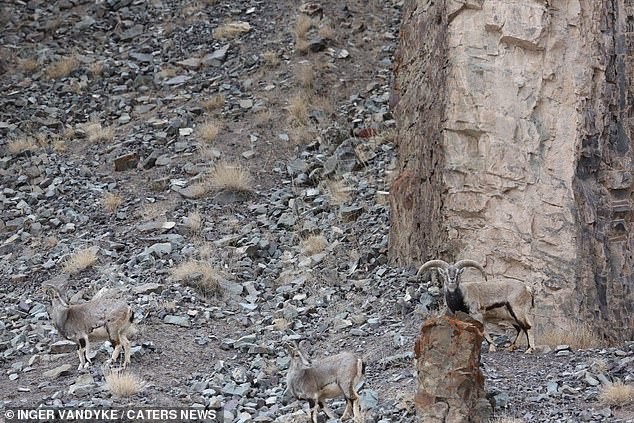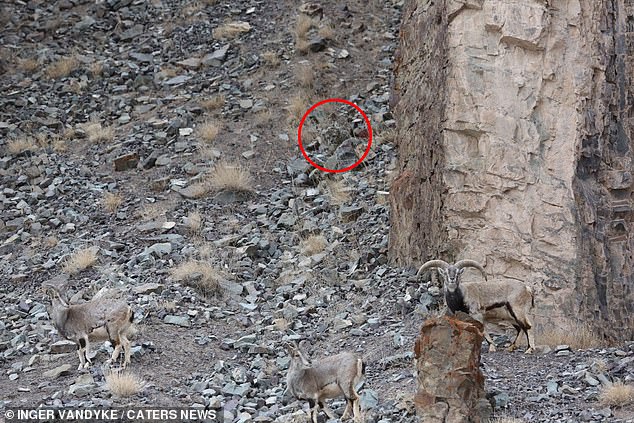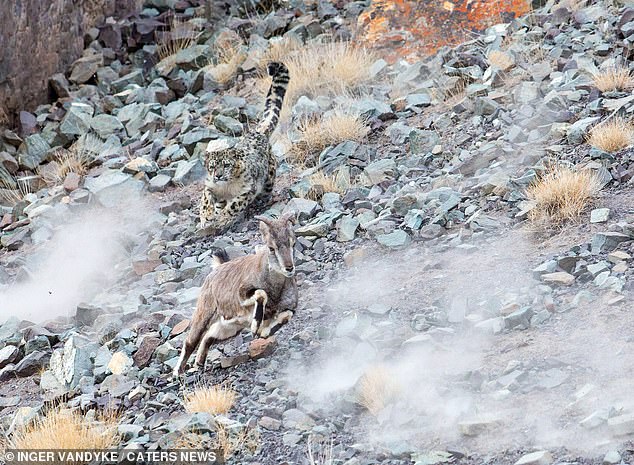At first glance, this image appears to just show a rocky mountain face – but a dangerous predator is hiding in plain sight.
Upon closer inspection, a snow leopard can be seen inching its way toward some unsuspecting prey – can you spot it?
Thanks to its grey and black speckled fur and white tummy the predator blends perfectly into the taupe-coloured background and is nearly invisible.
The big cats are renowned for being masters of disguise and can only be spotted by those with sharp vision.
Photographer Inger Vandyke captured the rare moment whilst braving freezing temperatures and tracking the elusive big cat across scree slopes in Ladakh, India.
The leopard had been resting on a ledge before suddenly springing into action when a herd of Blue Sheep wandered into view.

At first glance this image appears to only show a rocky mountain face – but there’s a dangerous predator hiding in plain sight
Although the big cat missed its target, Inger managed to snap a full sequence of the attempted hunt, a breathtaking moment of nature in motion.
Scan the picture from top to bottom to search for the sneaky creature
Have you found the leopard yet? And if so, how long did it take you?
Once you have located the big furry cat, you’ll kick yourself for not finding it sooner.
But, if you’re still struggling, draw your eyes towards the rocks on the right side of the image, and you’ll see the carnivore crouching amongst them.
Known as ‘ghosts of the Himalayas’, these dexterous creatures get their name from their spotted white fur, which helps to keep them well insulated in the harsh weather.
Snow leopards are sparsely located in 12 countries, in central Asia – including Mongolia, China, Afghanistan, Pakistan, India and Nepal.
However, these creatures won’t stay in one place for long as they can impressively travel over 25 miles in a single night – almost the distance of a marathon.

There it is! Did you find it? The big cats are renowned for being masters of disguise and can only be spotted by those with sharp vision

Although the big cat missed its target, Inger managed to snap a full sequence of the attempted hunt, a breathtaking moment of nature in motion
Snow leopards are currently under threat from habitat loss and degradation as a result of climate change and human encroachment, retaliatory killings resulting from human-wildlife conflict, reduced prey, and poaching.
Because of their long fur and less distinctive markings that seem to change shape with body movement, identifying individual snow leopards can be difficult compared to other big cats like tigers, leopards and jaguars, which have more distinctive markings.
Snow leopard’s homes are rugged mountain landscapes and can reach heights of over 3,000 metres, where they prey on mountain sheep and goats.
Their fur can grow up to 12cm long on their belly and is perfect for their high-altitude mountainous terrain.
Each country calls their snow leopards by a different name, in Tibet, where the creature is pictured, they are referred to as Sah or Shen.
The species is deemed vulnerable by the World Wildlife Fund (WWF), with around only 4,000 remaining.
The big cat can impressively kill prey up to three times their own weight in their challenging terrain.
There are an estimated 4,080 to 6,590 snow leopards left in the wild and they are listed as ‘Vulnerable’ by the International Union for Conservation of Nature (IUCN).












